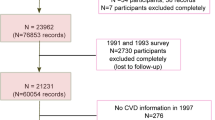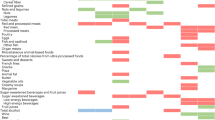Abstract
Background:
The German food pyramid was set up to foster and communicate healthy food choices.
Methods:
The adherence to recommendations of the food pyramid was translated into an index (German Food Pyramid Index (GFPI)) by scoring the ratio of consumed and recommended daily servings of eight food groups, wherein higher scores indicated greater adherence. The GFPI was calculated for 23 531 subjects who participated in the European Prospective Investigation into Cancer and Nutrition-Potsdam study and were recruited between 1994 and 1998. Associations between quintiles of GFPI scores and risk of incident cardiovascular diseases (CVD), type-2 diabetes (T2D) and cancer were evaluated using Cox proportional hazard regression models. During 183 740 person-years of follow-up, 363 incident cases of CVD (myocardial infarction or stroke), 837 incident cases of T2D and 844 incident cases of cancer occurred.
Results:
The GFPI was inversely related to CVD risk in men (multivariable-adjusted hazard ratio (HR) for highest versus lowest quintiles=0.56; 95% confidence interval (CI): 0.34–0.94) but not in women (HR=1.39; 95% CI: 0.76–2.55). No association between GFPI and cancer was observed. An inverse relation between GFPI and T2D (men: HR= 0.71 (0.52–0.97); women: HR= 0.69 (0.50–0.96)) in age-adjusted models was substantially attenuated after multivariable adjustments, particularly by body mass index (BMI) (men: HR=0.94 (0.69–1.30); women: HR=1.09 (0.77–1.54)). The same was observed for overall major chronic disease risk (CVD, T2D and total cancer).
Conclusion:
Adherence to the German food pyramid recommendations is not associated with a decreased risk of chronic diseases when considering BMI as confounder, except of CVD in men.
This is a preview of subscription content, access via your institution
Access options
Subscribe to this journal
Receive 12 print issues and online access
$259.00 per year
only $21.58 per issue
Buy this article
- Purchase on Springer Link
- Instant access to full article PDF
Prices may be subject to local taxes which are calculated during checkout
Similar content being viewed by others
References
Bergmann MM, Bussas U, Boeing H (1999). Follow-up procedures in EPIC-Germany—data quality aspects. European Prospective Investigation into Cancer and Nutrition. Ann Nutr Metab 43, 225–234.
Boeing H, Bohlscheid-Thomas S, Voss S, Schneeweiss S, Wahrendorf J (1997). The relative validity of vitamin intakes derived from a food frequency questionnaire compared to 24-hour recalls and biological measurements: results from the EPIC pilot study in Germany. European Prospective Investigation into Cancer and Nutrition. Int J Epidemiol 26 (Suppl 1), S82–S90.
Boeing H, Korfmann A, Bergmann MM (1999a). Recruitment procedures of EPIC-Germany. European Investigation into Cancer and Nutrition. Ann Nutr Metab 43, 205–215.
Boeing H, Wahrendorf J, Becker N (1999b). EPIC-Germany–a source for studies into diet and risk of chronic diseases. European Investigation into Cancer and Nutrition. Ann Nutr Metab 43, 195–204.
Bohlscheid-Thomas S, Hoting I, Boeing H, Wahrendorf J (1997a). Reproducibility and relative validity of energy and macronutrient intake of a food frequency questionnaire developed for the German part of the EPIC project. European Prospective Investigation into Cancer and Nutrition. Int J Epidemiol 26 (Suppl 1), S71–S81.
Bohlscheid-Thomas S, Hoting I, Boeing H, Wahrendorf J (1997b). Reproducibility and relative validity of food group intake in a food frequency questionnaire developed for the German part of the EPIC project. European Prospective Investigation into Cancer and Nutrition, Int J Epidemiol 26 (Suppl 1), S59–S70.
Buijsse B, Feskens EJ, Schulze MB, Forouhi NG, Wareham NJ, Sharp S et al. (2009). Fruit and vegetable intakes and subsequent changes in body weight in European populations: results from the project on diet, obesity, and genes (DiOGenes). Am J Clin Nutr 90, 202–209.
DGE (2008). Reference Values for Nutrient Intake (Referenzwerte fr die Nährstoffzufuhr), v. 1. Auflage, 3. vollständig durchgelesener und korrigierter Nachdruck, p 240.
Du H, van der AD, Boshuizen HC, Forouhi NG, Wareham NJ, Halkjaer J et al. (2010). Dietary fiber and subsequent changes in body weight and waist circumference in European men and women. Am J Clin Nutr 91, 329–336.
Ford ES, Bergmann MM, Kroger J, Schienkiewitz A, Weikert C, Boeing H (2009). Healthy living is the best revenge: findings from the European prospective investigation into cancer and nutrition-Potsdam study. Arch Intern Med 169, 1355–1362.
Guenther PM, Reedy J, Krebs-Smith SM, Reeve BB, Basiotis PP (2007). Development and Evaluation of the Healthy Eating Index. http://www.cnpp.usda.gov/HealthyEatingIndex.htm. Center for Nutrition Policy and Promotion, US Departement of Agriculture.
Haftenberger M, Schuit AJ, Tormo MJ, Boeing H, Wareham N, Bueno-de-Mesquita HB et al. (2002). Physical activity of subjects aged 50–64 years involved in the European Prospective Investigation into Cancer and Nutrition (EPIC). Public Health Nutr 5, 1163–1176.
Harnack L, Nicodemus K, Jacobs Jr DR, Folsom AR (2002). An evaluation of the dietary guidelines for Americans in relation to cancer occurrence. Am J Clin Nutr 76, 889–896.
Heitmann BL, Lissner L (1996). Obese individuals underestimate their food intake—which food groups are under-reported? Ugeskr Laeger 158, 6902–6906.
Kennedy ET, Ohls J, Carlson S, Fleming K (1995). The healthy eating index: design and applications. J Am Diet Assoc 95, 1103–1108.
Koelsch C, Brüggemann I (2007). The German Food Pyramid (Die aid-Ernährungspyramide- Richtig essen lehren und lernen): allgemeiner Infodienst für Ernährung, Landwirtschaft und Verbraucherschutz (www.aid.de).
Kristal AR, Peters U, Potter JD (2005). Is it time to abandon the food frequency questionnaire? Cancer Epidemiol Biomarkers Prev 14, 2826–2828.
Kroke A, Klipstein-Grobusch K, Voss S, Moseneder J, Thielecke F, Noack R et al. (1999). Validation of a self-administered food-frequency questionnaire administered in the European Prospective Investigation into Cancer and Nutrition (EPIC) Study: comparison of energy, protein, and macronutrient intakes estimated with the doubly labeled water, urinary nitrogen, and repeated 24-h dietary recall methods. Am J Clin Nutr 70, 439–447.
McCullough ML, Feskanich D, Rimm EB, Giovannucci EL, Ascherio A, Variyam JN et al. (2000a). Adherence to the dietary guidelines for Americans and risk of major chronic disease in men. Am J Clin Nutr 72, 1223–1231.
McCullough ML, Feskanich D, Stampfer MJ, Rosner BA, Hu FB, Hunter DJ (2000b). Adherence to the dietary guidelines for Americans and risk of major chronic disease in women. Am J Clin Nutr 72, 1214–1222.
McNaughton SA, Ball K, Crawford D, Mishra GD (2008). An index of diet and eating patterns is a valid measure of diet quality in an Australian population. J Nutr 138, 86–93.
Osler M, Heitmann BL, Gerdes LU, Jorgensen LM, Schroll M (2001). Dietary patterns and mortality in Danish men and women: a prospective observational study. Br J Nutr 85, 219–225.
Osler M, Helms Andreasen A, Heitmann B, Hoidrup S, Gerdes U, Morch Jorgensen L (2002). Food intake patterns and risk of coronary heart disease: a prospective cohort study examining the use of traditional scoring techniques. Eur J Clin Nutr 56, 568–574.
Schofield WN (1985). Predicting basal metabolic rate, new standards and review of previous work. Hum Nutr Clin Nutr 39 (Suppl 1), 5–41.
Shatenstein B, Nadon S, Godin C, Ferland G (2005). Diet quality of Montreal-area adults needs improvement: estimates from a self-administered food frequency questionnaire furnishing a dietary indicator score. J Am Diet Assoc 105, 1251–1260.
Slimani N, Ferrari P, Ocke M, Welch A, Boeing H, Liere M et al. (2000). Standardization of the 24-hour diet recall calibration method used in the European prospective investigation into cancer and nutrition (EPIC): general concepts and preliminary results. Eur J Clin Nutr 54, 900–917.
Taechangam S, Pinitchun U, Pachotikarn C (2008). Development of nutrition education tool: healthy eating index in Thailand. Asia Pac J Clin Nutr 17 (Suppl 1), 365–367.
Voss S, Kroke A, Klipstein-Grobusch K, Boeing H (1997). Obesity as a major determinant of underreporting in a self-administered food frequency questionnaire: results from the EPIC-Potsdam Study. Z Ernahrungswiss 36, 229–236.
Waijers PM, Feskens EJ, Ocke MC (2007). A critical review of predefined diet quality scores. Br J Nutr 97, 219–231.
WHO (2003). Diet, nutrition and the prevention of chronic diseases. World Health Organ Tech Rep Ser 916 p. i-viii, 1–149, backcover.
Woodruff SJ, Hanning RM (2010). Development and implications of a revised Canadian Healthy Eating Index (HEIC-2009). Public Health Nutr 13, 1–6.
Yannakoulia M, Panagiotakos DB, Pitsavos C, Bathrellou E, Chrysohoou C, Skoumas Y et al. (2007). Low energy reporting related to lifestyle, clinical, and psychosocial factors in a randomly selected population sample of Greek adults: the ATTICA Study. J Am Coll Nutr 26, 327–333.
Acknowledgements
We thank our study participants. We also thank Ellen Kohlsdorf and Wolfgang Bernigau for data management and Wolfgang Fleischhauer for case ascertainment. The recruitment phase of the EPIC-Potsdam Study was supported by the Federal Ministry of Science, Germany (grant 01 EA 9401). Further financial support was provided by the ‘Europe against Cancer’ program of the European Community (grant SOC 95 201408 05F02). The EPIC-Potsdam Study is now supported by the German Cancer Aid (grant 70-2488-Ha I) and the European Community (grant SOC 98 200769 05F02). BB was funded by FP-6 (Integrated Project LSHM-CT-2006-037197).
Author information
Authors and Affiliations
Corresponding author
Ethics declarations
Competing interests
The authors declare no conflict of interest.
Rights and permissions
About this article
Cite this article
von Ruesten, A., Illner, AK., Buijsse, B. et al. Adherence to recommendations of the German food pyramid and risk of chronic diseases: results from the EPIC-Potsdam study. Eur J Clin Nutr 64, 1251–1259 (2010). https://doi.org/10.1038/ejcn.2010.151
Received:
Revised:
Accepted:
Published:
Issue Date:
DOI: https://doi.org/10.1038/ejcn.2010.151
Keywords
This article is cited by
-
Adherence of pregnant women to Nordic dietary guidelines in relation to postpartum weight retention: results from the Norwegian Mother and Child Cohort Study
BMC Public Health (2014)
-
Adherence to predefined dietary patterns and incident type 2 diabetes in European populations: EPIC-InterAct Study
Diabetologia (2014)
-
Diet and risk of chronic diseases: results from the first 8 years of follow-up in the EPIC-Potsdam study
European Journal of Clinical Nutrition (2013)



